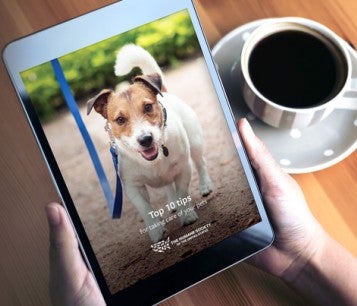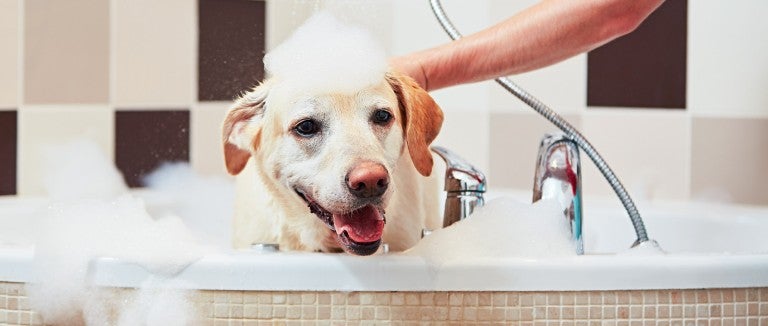Grooming doesn't just keep your dog looking good and smelling nice—regular maintenance of your dog’s fur, ears, nails and teeth prevents painful and costly health issues that may require a veterinarian. Many pet owners outsource these tasks to professional groomers, but this can be costly, and there may be a shortage of qualified groomers in your area. The good news is that with patience, practice and plenty of treats and praise, you can perform some or all necessary grooming tasks at home.
What grooming tools do I need?
- Rubber-bristled brush, wire slicker, steel comb and/or de-shedding tool
- Nail clippers (specifically for dogs) and/or Dremel grinder
- Styptic pencil (for accidental bleeding)
- Toothbrush and toothpaste (specifically for dogs)
- Cotton balls and/or soft, reusable cloth squares
- Blunt ended (round tip) shears and/or a small clipper with guide combs
- Shampoo (specifically for dogs) and conditioner (optional, specifically for dogs)
- Microfiber towel
- Hair dryer (optional)
How often should I brush and bathe my dog?
First, determine your dog’s coat type: Bulldog and dachshund types typically have short, smooth coats; Airedale and cairn terrier types have rough, wiry coats; Shih Tzu types have long, silky coats; dogs such as poodles and spaniels have curly coats; and dogs such as Labradors have double coats (a short, fuzzy undercoat and a medium, silky outer coat).
If your dog has a:
- Short, smooth or wiry coat, brush them once a week with a rubber-bristled brush to distribute skin oils through the fur.
- Long, silky or curly coat, brush them once a day with a rubber-bristled brush or wire slicker brush followed by a steel comb, if needed, to prevent tangles and mats and remove debris.
- Double coat, gently de-shed them once a week with an undercoat rake or de-shedding tool in addition to their regular brushing routine.
All long-haired dogs will need a full professional or at-home grooming, which includes a bath and haircut, every 4-8 weeks; short-haired dogs will benefit from a monthly bath.
Water worsens mats, so brush your dog before bath time. Use a shampoo specifically formulated for dogs, keeping it out of your dog’s eyes and ears, and use a damp cloth or cotton ball to wipe away outer eye discharge and gently clean away outer ear wax. Never push anything into your dog’s eyes or ears. Dogs with floppy ears are more likely to develop ear infections—keep an eye out for redness, discharge, odor or pawing at the ears and consult a veterinarian if needed.
Post-bath, dry your dog with a microfiber towel and/or a hair dryer on a low setting, moving it in a back-and-forth motion and holding it away from your dog’s skin to prevent burns.
Sign up to receive our exclusive e-book full of important information about caring for your pet, including training techniques and answers to frequently asked questions.

How can I cut my dog’s fur?
Three words: Carefully, slowly and sparingly. Before getting started, consider watching an informational YouTube video from a reputable groomer. Unless you’ve groomed your dog since puppyhood, it will likely take several months of gradual exposure before they’re comfortable with shears or clippers.
- Brush, bathe and thoroughly dry your dog.
- Using blunt ended (round tip) shears or small clippers with guide combs, trim hair that’s covering the eyes, long hair covering private parts and hair between dogs’ paw pads, if needed. A number 10 blade may work best in delicate areas.
- If desired, perform a light overall trim, keeping blades far away from your dog’s skin. A number four blade may work best for an overall trim.
How often should I trim my dog’s nails?
Prevent pain and damage to your dog’s paws by trimming your dog’s nails before they touch the ground. Most dogs will need a nail trim every 3-4 weeks.
Trim the part of the nail that turns down and avoid the quick (the pink part you can see on a white nail), which will bleed if cut. If your dog has dark nails, trim only a little at a time until you see evidence of the quick in the center of the nail, then stop. Keep a styptic pencil on hand to stop any accidental bleeding.
Depending on which you and your dog prefer, you can use a sharp nail clipper made specifically for dogs (choose the appropriate size for your dog) or a Dremel grinder. Most dogs will need some time to acclimate to either tool. Trimming—or even just pretending to trim—one nail a day and following it with a treat and praise is a measured but effective way to work up to regular, fuss-free nail trims.
How often should I brush my dog’s teeth?
Brush your dog’s teeth as frequently as possible (up to twice a day, like us humans) to prevent gum disease that can damage the heart, liver and kidneys and the need for costly professional teeth cleanings or mouth surgeries. Plaque hardens to tartar in just a few days, and tartar can only be removed during a professional teeth cleaning by a veterinarian. Small dogs are especially prone to teeth issues, as their teeth tend to be more crowded than larger dogs’.
Use a soft toothbrush and toothpaste made specifically for dogs. Never use human toothpaste, which can be toxic to dogs.
Dental treats can help reduce plaque buildup, but only if your dog takes enough time to really chew the treat before swallowing it. If your dog enjoys them, inedible dental chews can also help, but neither are a substitute for regular teeth brushing.
Should I expel my dog’s anal glands?
No. You could injure your dog or even cause the glands to become impacted. Your dog’s anal glands naturally express themselves and leave a scent signature for other dogs every time they poop. If you notice your is dog scooting their bottom across the carpet, chewing at their glands or emitting a foul odor, add a tablespoon of canned pumpkin or Metamucil to their food to help their glands express themselves, and seek advice from your veterinarian.
